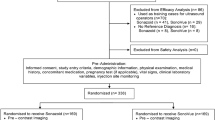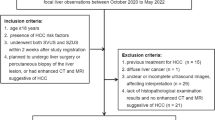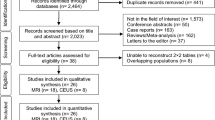Abstract
Objectives
This meta-analysis was performed to evaluate the accuracy of contrast-enhanced ultrasound (CEUS) in differentiating malignant from benign focal liver lesions (FLLs).
Methods
Cochrane Library, PubMed and Web of Science databases were systematically searched and checked for studies using CEUS in characterization of FLLs. Data necessary to construct 2×2 contingency tables were extracted from included studies. The QUADAS tool was utilized to assess the methodologic quality of the studies. Meta-analysis included data pooling, subgroup analyses, meta-regression and investigation of publication bias was comprehensively performed.
Results
Fifty-seven studies were included in this meta-analysis and the overall diagnostic accuracy in characterization of FLLs was as follows: pooled sensitivity, 0.92 (95%CI: 0.91–0.93); pooled specificity, 0.87 (95%CI: 0.86–0.88); diagnostic odds ratio, 104.20 (95%CI: 70.42–154.16). Subgroup analysis indicated higher diagnostic accuracy of the second-generation contrast agents (CAs) than the first-generation CA (Levovist; DOR: 118.27 vs. 62.78). Furthermore, Sonazoid demonstrated the highest diagnostic accuracy among three major CAs (SonoVue, Levovist and Sonazoid; DOR: 118.82 vs. 62.78 vs. 227.39). No potential publication bias was observed of the included studies.
Conclusion
CEUS is an accurate tool to stratify the risk of malignancy in FLLs. The second-generation CAs, especially Sonazoid may greatly improve diagnostic performance.
Key Points
• CEUS shows excellent diagnostic accuracy in differentiating malignant from benign FLLs.
• The second-generation CAs have higher diagnostic accuracy than first-generation CAs.
• Sonazoid demonstrates the highest diagnostic accuracy among three major CAs.






Similar content being viewed by others
Abbreviations
- CEUS:
-
Contrast-enhanced ultrasound
- FLLs:
-
Focal liver lesions
- CAs:
-
Contrast agents
- CA:
-
Contrast agent
- QUADAS:
-
Quality Assessment of Diagnostic Accuracy Studies
- TP:
-
True positive
- TN:
-
True negative
- FP:
-
False positive
- FN:
-
False negative
- DOR:
-
Diagnostic odds ratio
- PLR:
-
Positive likelihood ratio
- NLR:
-
Negative likelihood ratio
- CIs:
-
Confidence intervals
- HSROC:
-
Hierarchical summary receiver operating characteristic
- AUC:
-
Area under the curve
- RDOR:
-
Relative diagnostic odds ratio
- UL:
-
Upper limit
- LL:
-
Lower limit
- HCCs:
-
Hepatocellular carcinomas
- RES:
-
Reticuloendothelial system
References
Gatos I, Tsantis S, Spiliopoulos S et al (2015) A new automated quantification algorithm for the detection and evaluation of focal liver lesions with contrast-enhanced ultrasound. Med Phys 42:3948–3959
Salvatore V, Borghi A, Piscaglia F (2012) Contrast-enhanced ultrasound for liver imaging: recent advances. Curr Pharm Des 18:2236–2252
Lencioni R, Piscaglia F, Bolondi L (2008) Contrast-enhanced ultrasound in the diagnosis of hepatocellular carcinoma. J Hepatol 48:848–857
Deng H, Shi H, Lei J, Hu Y, Li G, Wang C (2016) A meta-analysis of contrast-enhanced ultrasound for small hepatocellular carcinoma diagnosis. J Cancer Res Ther 12:C274–C276
Yoon JH, Park JW, Lee JM (2016) Noninvasive Diagnosis of Hepatocellular Carcinoma: Elaboration on Korean Liver Cancer Study Group-National Cancer Center Korea Practice Guidelines Compared with Other Guidelines and Remaining Issues. Korean J Radiol 17:7–24
Guang Y, Xie L, Ding H, Cai A, Huang Y (2011) Diagnosis value of focal liver lesions with SonoVue®-enhanced ultrasound compared with contrast-enhanced computed tomography and contrast-enhanced MRI: a meta-analysis. J Cancer Res Clin Oncol 137:1595–1605
Ignee A, Atkinson NS, Schuessler G, Dietrich CF (2016) Ultrasound contrast agents. Endosc Ultrasound 5:355–362
Paefgen V, Doleschel D, Kiessling F (2015) Evolution of contrast agents for ultrasound imaging and ultrasound-mediated drug delivery. Front Pharmacol 15:197
Maruyama H, Sekimoto T, Yokosuka O (2016) Role of contrast-enhanced ultrasonography with Sonazoid for hepatocellular carcinoma: evidence from a 10-year experience. J Gastroenterol 51:421–433
Kondo S, Takagi K, Nishida M et al (2017) Computer-Aided Diagnosis of Focal Liver Lesions Using Contrast-Enhanced Ultrasonography With Perflubutane Microbubbles. IEEE Trans Med Imaging 36:1427–1437
Seitz K, Strobel D (2016) A Milestone: Approval of CEUS for Diagnostic Liver Imaging in Adults and Children in the USA. Ultraschall Med 37:229–232
Hohmann J, Skrok J, Basilico R et al (2012) Characterisation of focal liver lesions with unenhanced and contrast enhanced low MI real time ultrasound: on-site unblinded versus off-site blinded reading. Eur J Radiol 81:e317–e324
Shan QY, Chen LD, Zhou LY et al (2016) Focal Lesions in Fatty Liver: If Quantitative Analysis Facilitates the Differentiation of Atypical Benign from Malignant Lesions. Sci Rep 6:18640
Quaia E, De Paoli L, Angileri R, Cabibbo B, Cova MA (2014) Indeterminate solid hepatic lesions identified on non-diagnostic contrast-enhanced computed tomography: assessment of the additional diagnostic value of contrast-enhanced ultrasound in the non-cirrhotic liver. Eur J Radiol 83:456–462
Ryu SW, Bok GH, Jang JY et al (2014) Clinically useful diagnostic tool of contrast enhanced ultrasonography for focal liver masses: comparison to computed tomography and magnetic resonance imaging. Gut Liver 8:292–297
Sporea I, Badea R, Popescu A et al (2014) Contrast-enhanced ultrasound (CEUS) for the evaluation of focal liver lesions - a prospective multicenter study of its usefulness in clinical practice. Ultraschall Med 35:259–266
Zhang P, Zhou P, Tian SM, Qian Y, Li JL, Li RZ (2014) Diagnostic performance of contrast-enhanced sonography and acoustic radiation force impulse imaging in solid liver lesions. J Ultrasound Med 33:205–214
Jacob J, Deganello A, Sellars ME, Hadzic N, Sidhu PS (2013) Contrast enhanced ultrasound (CEUS) characterization of grey-scale sonographic indeterminate focal liver lesions in pediatric practice. Ultraschall Med 34:529–540
Streba CT, Ionescu M, Gheonea DI et al (2012) Contrast-enhanced ultrasonography parameters in neural network diagnosis of liver tumors. World J Gastroenterol 18:4427–4434
Anaye A, Perrenoud G, Rognin N et al (2011) Differentiation of focal liver lesions: usefulness of parametric imaging with contrast-enhanced US. Radiology 261:300–310
Bartolotta TV, Taibbi A, Midiri M, Matranga D, Solbiati L, Lagalla R (2011) Indeterminate focal liver lesions incidentally discovered at gray-scale US: role of contrast-enhanced sonography. Investig Radiol 46:106–115
Giorgio A, Calisti G, di Sarno A et al (2011) Characterization of dysplastic nodules, early hepatocellular carcinoma and progressed hepatocellular carcinoma in cirrhosis with contrast-enhanced ultrasound. Anticancer Res 31:3977–3982
Strobel D, Bernatik T, Blank W et al (2011) Diagnostic accuracy of CEUS in the differential diagnosis of small (≤20 mm) and subcentimetric (≤10 mm) focal liver lesions in comparison with histology. Results of the DEGUM multicenter trial. Ultraschall Med 32:593–597
Beaton C, Cochlin D, Kumar N (2010) Contrast enhanced ultrasound should be the initial radiological investigation to characterise focal liver lesions. Eur J Surg Oncol 36:43–46
Ooi CC, Low SC, Schneider-Kolsky M et al (2010) Diagnostic accuracy of contrast-enhanced ultrasound in differentiating benign and malignant focal liver lesions: a retrospective study. J Med Imaging Radiat Oncol 54:421–430
Rognin NG, Arditi M, Mercier L et al (2010) Parametric imaging for characterizing focal liver lesions in contrast-enhanced ultrasound. IEEE Trans Ultrason Ferroelectr Freq Control 57:2503–2511
von Herbay A, Westendorff J, Gregor M (2010) Contrast-enhanced ultrasound with SonoVue: differentiation between benign and malignant focal liver lesions in 317 patients. J Clin Ultrasound 38:1–9
Inoue T, Kudo M, Maenishi O et al (2009) Value of liver parenchymal phase contrast-enhanced sonography to diagnose premalignant and borderline lesions and overt hepatocellular carcinoma. AJR Am J Roentgenol 192:698–705
Jang HJ, Kim TK, Wilson SR (2009) Small nodules (1-2 cm) in liver cirrhosis: characterization with contrast-enhanced ultrasound. Eur J Radiol 72:418–424
Liu GJ, Xu HX, Xie XY et al (2009) Does the echogenicity of focal liver lesions on baseline gray-scale ultrasound interfere with the diagnostic performance of contrast-enhanced ultrasound? Eur Radiol 19:1214–1222
Moriyasu F, Itoh K (2009) Efficacy of perflubutane microbubble-enhanced ultrasound in the characterization and detection of focal liver lesions: phase 3 multicenter clinical trial. AJR Am J Roentgenol 193:86–95
Quaia E, Alaimo V, Baratella E, Medeot A, Midiri M, Cova MA (2009) The added diagnostic value of 64-row multidetector CT combined with contrast-enhanced US in the evaluation of hepatocellular nodule vascularity: implications in the diagnosis of malignancy in patients with liver cirrhosis. Eur Radiol 19:651–663
Sugimoto K, Shiraishi J, Moriyasu F, Doi K (2009) Computer-aided diagnosis of focal liver lesions by use of physicians' subjective classification of echogenic patterns in baseline and contrast-enhanced ultrasonography. Acad Radiol 16:401–411
Trillaud H, Bruel JM, Valette PJ et al (2009) Characterization of focal liver lesions with SonoVue-enhanced sonography: international multicenter-study in comparison to CT and MRI. World J Gastroenterol 15:3748–3756
Wang WP, Wu Y, Luo Y et al (2009) Clinical value of contrast-enhanced ultrasonography in the characterization of focal liver lesions: a prospective multicenter trial. Hepatobiliary Pancreat Dis Int 8:370–376
Zuber-Jerger I, Schacherer D, Woenckhaus M, Jung EM, Schölmerich J, Klebl F (2009) Contrast-enhanced ultrasound in diagnosing liver malignancy. Clin Hemorheol Microcirc 43:109–118
D'Onofrio M, Faccioli N, Zamboni G et al (2008) Focal liver lesions in cirrhosis: value of contrast-enhanced ultrasonography compared with Doppler ultrasound and alpha-fetoprotein levels. Radiol Med 113:978–991
Hatanaka K, Kudo M, Minami Y, Maekawa K (2008) Sonazoid-enhanced ultrasonography for diagnosis of hepatic malignancies: comparison with contrast-enhanced CT. Oncology 75:42–47
Shiraishi J, Sugimoto K, Moriyasu F, Kamiyama N, Doi K (2008) Computer-aided diagnosis for the classification of focal liver lesions by use of contrast-enhanced ultrasonography. Med Phys 35:1734–1746
Strobel D, Seitz K, Blank W et al (2008) Contrast-enhanced ultrasound for the characterization of focal liver lesions--diagnostic accuracy in clinical practice (DEGUM multicenter trial). Ultraschall Med 29:499–505
Wang ZL, Tang J, Weskott HP et al (2008) Undetermined focal liver lesions on gray-scale ultrasound in patients with fatty liver: characterization with contrast-enhanced ultrasound. J Gastroenterol Hepatol 23:1511–1519
Catala V, Nicolau C, Vilana R et al (2007) Characterization of focal liver lesions: comparative study of contrast-enhanced ultrasound versus spiral computed tomography. Eur Radiol 17:1066–1073
Celli N, Gaiani S, Piscaglia F et al (2007) Characterization of liver lesions by real-time contrast-enhanced ultrasonography. Eur J Gastroenterol Hepatol 19:3–14
Dai Y, Chen MH, Yin SS et al (2007) Focal liver lesions: can SonoVue-enhanced ultrasound be used to differentiate malignant from benign lesions? Investig Radiol 42:596–603
Jung EM, Clevert DA, Schreyer AG et al (2007) Evaluation of quantitative contrast harmonic imaging to assess malignancy of liver tumors: a prospective controlled two-center study. World J Gastroenterol 13:6356–6364
Quaia E, D'Onofrio M, Cabassa P et al (2007) Diagnostic value of hepatocellular nodule vascularity after microbubble injection for characterizing malignancy in patients with cirrhosis. AJR Am J Roentgenol 189:1474–1483
Xu J, Wu Y, Dong F (2007) Clinical value of contrast-enhanced ultrasound in differentiating benign and malignant focal liver lesions. J Huazhong Univ Sci Technolog Med Sci 27:703–705
Leen E, Ceccotti P, Kalogeropoulou C, Angerson WJ, Moug SJ, Horgan PG (2006) Prospective multicenter trial evaluating a novel method of characterizing focal liver lesions using contrast-enhanced sonography. AJR Am J Roentgenol 186:1551–1559
Nicolau C, Vilana R, Catalá V et al (2006) Importance of evaluating all vascular phases on contrast-enhanced sonography in the differentiation of benign from malignant focal liver lesions. AJR Am J Roentgenol 186:158–167
Wang JH, Lu SN, Hung CH et al (2006) Small hepatic nodules (< or =2 cm) in cirrhosis patients: characterization with contrast-enhanced ultrasonography. Liver Int 26:928–934
Wu W, Chen MH, Yin SS et al (2006) The role of contrast-enhanced sonography of focal liver lesions before percutaneous biopsy. AJR Am J Roentgenol 187:752–761
Xu HX, Liu GJ, Lu MD et al (2006) Characterization of small focal liver lesions using real-time contrast-enhanced sonography: diagnostic performance analysis in 200 patients. J Ultrasound Med 25:349–361
Kim SH, Lee JM, Lee JY et al (2005) Value of contrast-enhanced sonography for the characterization of focal hepatic lesions in patients with diffuse liver disease: receiver operating characteristic analysis. AJR Am J Roentgenol 184:1077–1084
Bryant TH, Blomley MJ, Albrecht T et al (2004) Improved characterization of liver lesions with liver-phase uptake of liver-specific microbubbles: prospective multicenter study. Radiology 232:799–809
Dietrich CF, Ignee A, Trojan J et al (2004) Improved characterisation of histologically proven liver tumours by contrast enhanced ultrasonography during the portal venous and specific late phase of SHU 508A. Gut 53:401–405
Klein D, Jenett M, Gassel HJ, Sandstede J, Hahn D (2004) Quantitative dynamic contrast-enhanced sonography of hepatic tumors. Eur Radiol 14:1082–1091
Peschl R, Werle A, Mathis G (2004) Differential diagnosis of focal liver lesions in signal-enhanced ultrasound using BR 1, a second-generation ultrasound signal enhancer. Dig Dis 22:73–80
Quaia E, Calliada F, Bertolotto M et al (2004) Characterization of focal liver lesions with contrast-specific US modes and a sulfur hexafluoride-filled microbubble contrast agent: diagnostic performance and confidence. Radiology 232:420–430
Suzuki S, Iijima H, Moriyasu F et al (2004) Differential diagnosis of hepatic nodules using delayed parenchymal phase imaging of Levovist contrast ultrasound: comparative study with SPIO-MRI. Hepatol Res 29:122–126
von Herbay A, Vogt C, Willers R, Häussinger D (2004) Real-time imaging with the sonographic contrast agent SonoVue: differentiation between benign and malignant hepatic lesions. J Ultrasound Med 23:1557–1568
Isozaki T, Numata K, Kiba T et al (2003) Differential diagnosis of hepatic tumors by using contrast enhancement patterns at US. Radiology 229:798–805
Karabacakoglu A, Karakose S, Cil AS, Kaya A (2003) Contrast media-enhanced power Doppler sonography for evaluation of hemangiomas and malignant tumors in the liver. J Gastroenterol Hepatol 18:92–98
Strobel D, Raeker S, Martus P, Hahn EG, Becker D (2003) Phase inversion harmonic imaging versus contrast-enhanced power Doppler sonography for the characterization of focal liver lesions. Int J Color Dis 18:63–72
Beissert M, Delorme S, Mutze S et al (2002) Comparison of B-mode and conventional colour/power Doppler ultrasound, contrast-enhanced Doppler ultrasound and spiral CT in the diagnosis of focal lesions of the liver: Results of a multicentre study. Ultraschall Med 23:245–250
von Herbay A, Vogt C, Häussinger D (2002) Late-phase pulse-inversion sonography using the contrast agent levovist: differentiation between benign and malignant focal lesions of the liver. AJR Am J Roentgenol 179:1273–1279
Fracanzani AL, Burdick L, Borzio M et al (2001) Contrast-enhanced Doppler ultrasonography in the diagnosis of hepatocellular carcinoma and premalignant lesions in patients with cirrhosis. Hepatology 34:1109–1112
Perera RH, Hernandez C, Zhou H, Kota P, Burke A, Exner AA (2015) Ultrasound imaging beyond the vasculature with new generation contrast agents. Wiley Interdiscip Rev Nanomed Nanobiotechnol 7:593–608
Yanagisawa K, Moriyasu F, Miyahara T, Yuki M, Iijima H (2007) Phagocytosis of ultrasound contrast agent microbubbles by Kupffer cells. Ultrasound Med Biol 33:318–325
Claudon M, Cosgrove D, Albrecht T et al (2008) Guidelines and good clinical practice recommendations for contrast enhanced ultrasound (CEUS) -. update 2008. Ultraschall Med 29:28–44
Jang HJ, Yu H, Kim TK (2009) Contrast-enhanced ultrasound in the detection and characterization of liver tumors. Cancer Imaging 9:96–103
Funding
This study has received funding by the Youth Science Foundation of the Second Hospital Center Laboratory of Tianjin Medical University (2016YDEY01), Science Foundation of Tianjin Medical University (2016KYZQ06 and 2014KYM15), Foundation of Tianjin Health and Family Planning Commission (16KG115).
Author information
Authors and Affiliations
Corresponding authors
Ethics declarations
Guarantor
The scientific guarantor of this publication is Xuening Zhang.
Conflict of interest
The authors of this manuscript declare no relationships with any companies, whose products or services may be related to the subject matter of the article.
Statistics and biometry
No complex statistical methods were necessary for this paper.
Informed consent
Written informed consent was not required for this study because the study concerns a meta-analysis.
Ethical approval
Institutional review board approval was not required because the study concerns a meta-analysis.
Methodology
• diagnostic study
• performed at one institution
Additional information
Menglin Wu and Liang Li are co-first authors.
Rights and permissions
About this article
Cite this article
Wu, M., Li, L., Wang, J. et al. Contrast-enhanced US for characterization of focal liver lesions: a comprehensive meta-analysis. Eur Radiol 28, 2077–2088 (2018). https://doi.org/10.1007/s00330-017-5152-x
Received:
Revised:
Accepted:
Published:
Issue Date:
DOI: https://doi.org/10.1007/s00330-017-5152-x




